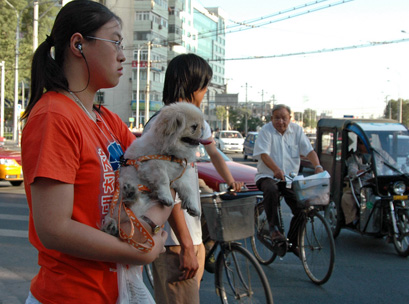The Philippines is a developing country with rampant poverty and a minimum salary of less than US$10 a day – yet it has a flourishing pet supplies retail and service sector.
Yes, pets can equal profit even in the most difficult of trading times.
I was told many years ago that the good restaurants can survive in tough times because people still dine out on special occasions and want to escape the realities of life. Well I can tell you here in the Philippines, (and I suspect all countries), you can add the pet industry to the short list of businesses that can also survive though the harshest of economic conditions.
Owning a pet comes with an emotional relationship that translates directly into spending lots of money!
Owning a pedigree dog is a popular practice in the Philippines and it is not restricted to the wealthy. To put the costs of owning a dog in perspective consider first the financial position of a middle class home. Income is P35 – 70,000 per month, (US$900 – $1600). A small 100sqm home in an estate costs P4 million, ($72,000). The cost of a small car is P1 million, ($24,000). The average food spend per week for three people is P5000, ($120). Electricity costs P5000, ($120). Petrol is P55 a litre, ($1.31). A lady’s trip to the salon costs P800 – P1000, ($10 – $12) and a gent’s haircut is P120 – 200, ($3 – $5).
It would seem spending money on a pet is a luxury most families could not afford to entertain however, this couldn’t be further from the truth.
A small pet shop and dog grooming salon opened in a mini mall two years ago. There is limited car parking space with around 15 spaces for the entire mini mall. The shop was only big enough to accommodate four or five customers maximum. My initial thoughts on this business were a difficult location in a difficult market in the wrong location. But, it has proved me wrong.
As frequent visitors to this store we observed puppies came and went quickly so it was apparent that selling purebred puppies for P10,000 to P16,000 ($250 – $400) was an easy challenge. It was from this store we bought Booze our Shih Tzu and so the saga of the cost to own and pamper a pooch began.
Injections were required to protect the puppy and to keep the growing dog healthy. The vet visits the shop on Sundays and because the demand is high appointments are necessary. On our first visit there were eight customers queued with their dogs to receive injections and that was just in the 45 minutes we were waiting our turn. Cost of injections averaged P600, ($15) per time and time taken for vet to examine the dog and give the injection was 10 minutes.
To put this in perspective I visit a heart specialist in Makati Medical which is one of the top hospitals in Manila and my basic consultation fee is P900. My time with the doctor to complete blood pressure reading, heart examination and discussion with doctor will be 20 minutes.
Visits for injections always resulted in “add on sales” with snacks or a new lead or toys or shampoo and the list goes on and on. Observing other customers confirmed this is standard behavior for pet owners and so the P600 injection visit became P800 with the “add-ons”.
Grooming the dog is another highly profitable income stream for the store. Again it is necessary to call the store in advance as getting a grooming appointment can also be difficult. Depending on whether the dog is to get basic wash and dry or the full make over the cost will be from P350 to P1200, ($9 – $30). The frequency of the grooming visits is at least monthly. However some customers do this weekly.
Again to put this cost in perspective, if my wife goes to the parlor her basic cost will be P800 and for my visit to the salon for a haircut complete with head and neck massage will be P160. Can you believe then the cost of the grooming for the dog is almost as expensive as the cost for a lady’s salon visit and at least double the cost for my haircut and this is all done with a smile because we love our dog!
Whilst the turnover and closure of stores in this mini mall has been staggeringly high, the little pet shop has moved into larger premises almost tripling the floor area. Judging on customer traffic and the fact we still have to book for vet visits and grooming appointments, (even though there are additional groomers), the sales for product and services have grown greater than the expansion cost.
So successful has this business been, a second similar concept has opened a mere five minutes down the road. They have placed signs on the roadside that promote prices up to 20 per cent cheaper than the mall shop and quickly developed a healthy customer base. Interestingly in talking with customers from the original store they remain loyal to the original store because “my dog likes it there”!
Then there is the cost of feeding the dog. From observing customers in the pet food section of the supermarket it is clear purebred dog owners spare no expense in feeding their beloved pet. Our small dog manages to chew his way through four cans of name brand pet food weekly with each can costing P116 so the weekly tally for his canned meals is P456.
In addition to the canned food we buy bags of dry food to supplement his diet and a medium size bag costs P270 and lasts no more than one month. Total weekly feeding cost is P525 and yes it is correct if you have already calculated his food is plus 10 per cent of the total supermarket bill.
Now we buy an international brand of canned dog food in large cans as this is the most economical way to purchase dog food but on the shelves are mini tins of gourmet food good for a single serve retailing at P72 each. If we fed our dog this “exclusive” brand our weekly cost would escalate to P770.
The lesson here is that even in tough economic retail times there are always opportunities for success. There are enormous opportunities for pet business operators and suppliers who can understand the “emotional drivers” in this market segment to grow business sales and profit thru:
- Opportunistic range structures.
- Add-on sales.
- Correct shelf allocation stock to sales ratios.
- Latest trend products.
- Emotional sale driven promotions.
- Promotions driven by the dog’s (pet’s) health and well being .
Of course it is not just in the Philippines that this phenomenon can be found – all through developing Asian economies, pedigree pets have become must-have accessories for the burgeoning middle class.
And last week a report was published by research house IbisWorld on the US pet retailing sector. It, too, concluded that pets were the most recession-proof category in the US.
“The trend was mainly driven by an increasing number of ‘pet parents’,” said Caitlin Moldvay, an IbisWorld industry analyst. “Pet owners who treat their four-legged friends as family members.”
During the economic downturn when consumers of all income levels tightened their belts, ‘pet parents’ cut back on their personal discretionary spending first before scaling down on their spending for their pets.
Consequently, revenue growth slowed during the recession but maintained its overall positive trend. Revenue is expected to increase at an average annual rate of 2.8 per cent to $14.7 billion in the five years to 2012.
I would write more but I have to rush out now to open a pet and grooming salon. It is money in the bank!
* InsideRetail.Asia columnist Darrell Wisbey has 30 years retail experience, living and working in Australia and Asia. He is based in the Philippines and a member of Impact Retailing. Email Darrell.






